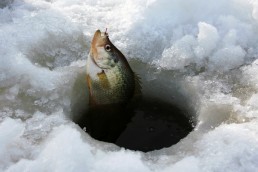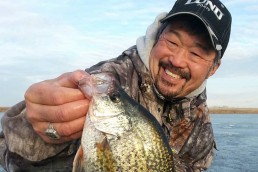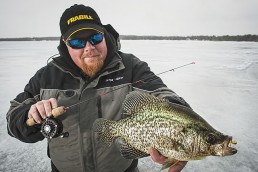Guide’s Secrets for Ice-out Slab Crappies
SHARE THIS POST
Have we exhausted every feasible place to catch crappies in the spring? I doubt it! There are places crappies hang out that anglers seemingly fail to think about. Time on the water, and being a geek about chasing big crappies in the spring, have driven me to adapt to changing conditions, and keep an open mind as to where the fish might be.
When winter’s lock begins to disappear, I’m already plotting my crappie directions and going over maps of potential locations. Depending on the weather, I define my potentials. I don’t want to sit at the landing on an ugly day and assume they won’t bite.
When I plot crappie moves, it’s to target those slabs that we all drool over. Like all fish, crappies need to eat, and when the ice goes out, some of the biggest slabs go on the hunt. It’s not uncommon to find big fish in shallow water, but don’t make the wrong assumption about why they’re up there in that skinny water. Many anglers believe that if they catch a crappie shallow after ice-out, that it’s a sign the spawning ritual is underway. Wrong! All species need nourishment before the spawn, and crappies are no different. Attacking certain bodies of water in search of big crappies is dependent on when the ice went out, the existence of the giant specimens we’re looking for, and the habitat in each body of water.
Deep-water proximity is key
After ice-out, several veteran crappie anglers I know key on spots where shallow flats are available, but deeper water is very nearby. They believe that crappies can be up in the shallow water during periods of warming and stable weather, but likely retreat into deeper water when cold fronts, windy conditions, and other inclement weather rolls in.
Half truths, no truths
Every early-season crappie article I read crowns the north end of the lake king of likely hangouts, and some even proclaim the north side the only spot you’re likely to find and catch early-season crappies. This is far from the truth, because, as usual, the reality is more complicated than blindly following your compass to one side of the lake.
Here’s another wive’s tale that can easily cause you to miss the bite: you must find spots that have a combination of mud, gravel, scattered hard bottom, and old pencil reeds or you’re not going to find crappies. Absolutely not true! Talk to panfisher extraordinaire Brian “Bro” Brosdahl and you’ll hear about countless hours chasing ice-out crappies and become enlightened about what makes them tick. Every situation is different, and Bro makes a living by figuring out where early-season crappies are hiding. Like myself, Bro uses an Aqua-Vu camera to scour the bottom looking for the right bottom composition likely to at least stall these ice-out roamers. When it comes to eliminating unproductive water, underwater cameras save a lot of valuable time.
Consistent depths
Shallow flats can, at times, be an absolute bonanza at this time of year. But I greatly value spots with at least slightly deeper water in direct proximity, so the crappies are likely to just slide out when weather changes occur. It makes staying on the fish much simpler.
I have taken some giants on 12- to 15-foot ledges near shallow flats. If I check the flats and can’t find crappies, I’ll go on the hunt in nearby deeper water, relying on a detailed contour map chip in my GPS to accurately control the boat, and my eyes are glued to the depthfinder for signs of life. (My personal unit is a Humminbird 999 SI, with a LakeMaster map chip.)
I’ve learned that if I turn on what’s called the Switchfire mode, which increases sensitivity, it’s easier to see small particles of minute organisms that represent crappie food. Finding areas loaded with such food items can help me predict where crappies are probably going to show up, even if they’re not there at the moment. Always remember that crappies, after ice-out, are looking for groceries, and will adapt to several different sources to nourish their systems before spawning. If you find food, save that location as a GPS waypoint, so you can return to the area and keep checking for the arrival of crappies.
Are you enjoying this post?
You can be among the first to get the latest info on where to go, what to use and how to use it!
Tackle and techniques
Small jigs are often the ticket for early crappies, because they are keying on small items that are easy prey. VMC Tinsel jigs, or the Hot Skirt variety, are some of my favorites. Dress them with a small minnow or chunk of Trigger X and now it’s up to you to put it in front of a willing fish.
When I’m checking shallow flats, I like to use a small bobber, largely as a strike indicator, and pitch the setup into as many likely spots as possible. I never let it sit too long in one place. Many times I’ll target a stalk of last season’s pencil reeds, or the edges of an exposed brush pile. These areas are good sources of food for ice-out crappies, and I can fish them quickly and efficiently. Many times, big slabs are loners, but you might pluck a couple off each small stickup. I keep on the move until I contact fish.
Modern equipment greatly helps me slowly and quietly search out potential fish-holding areas. I use a Minn Kota trolling motor, and have one mounted on the bow and one in the back. I also take advantage of i-Pilot technology, which links up my depthfinder to the trolling motor, allowing me to systematically dissect every inch of water that I think could be holding crappies. And not to make it sound like a commercial, but these fish are spooky, especially in shallow water, so when I catch a fish, I love to be able to quietly deploy the Talon anchoring system. It stops me in place, and when I’m ready to move again, the Talon slides back up at the touch of a button. Being able to move with stealth lets you stay with roaming schools of active crappies. You don’t have to have all of this gear to catch fish, but it really makes a difference for me.
Adjust to weather changes
When the weather alters your plans in the form of a cold front, increased wind, or a sudden drop in the barometer, seek the closet drop in depth. Many times, the crappies you were catching shallow during better weather will have pushed out deeper.
To catch them, I like to cast a jig-and-minnow and let it sink on a 5 count. Then I start a slow swimming retrieve. These negative crappies will bite on a slow, soft presentation, and will amaze you at the aggressiveness of the strikes.
Here’s my rig: I prefer a soft-action, 7-foot ultralight rod like the Tuff-Lite or Spinmatic Series, or DXW 7-foot light-action rod from Daiwa. They give me great sensitivity and help me cast small baits long distances. My current favorite reels for this type of fishing are Daiwa’s Aird 1000 and Laguna 500 spinning reels, spooled with 4-pound-test Sufix Elite line.
Sometimes the bite is so subtle it’s hard to react quickly enough, while at other times a big crappie will blister you. If I’m not using a small bobber, most often I let the rod tip load up gently, then firmly set the hook. Another little trick is adjustment in the line and certain situations that tend to alter what I do. I will, at times, switch to Sufix hi-viz yellow line to help me detect the slightest of bites by seeing the line twitch. You have to set the hook instantly.
Ice-out crappies can be easy to find, or you might have to search hard. We all face changing conditions, and the difference between success and failure comes from how willing we are to experiment, keep trying, and adapt. Just remember that staying home doesn’t put fish in the boat.
Book a day on the water with Tom Neustrom at mnfishingconnections.com.
MWO
SHARE THIS POST
Did you enjoy this post?
You can be among the first to get the latest info on where to go, what to use and how to use it!
Andrew Ragas
Andrew Ragas splits time between Chicago and Wisconsin’s Northwoods. Based in Minocqua, Wis., he specializes in trophy bass fishing and offers guided trips from May through October. While big bass are his passion, he dabbles in multispecies, as well. He may be visited online at northwoodsbass.com



